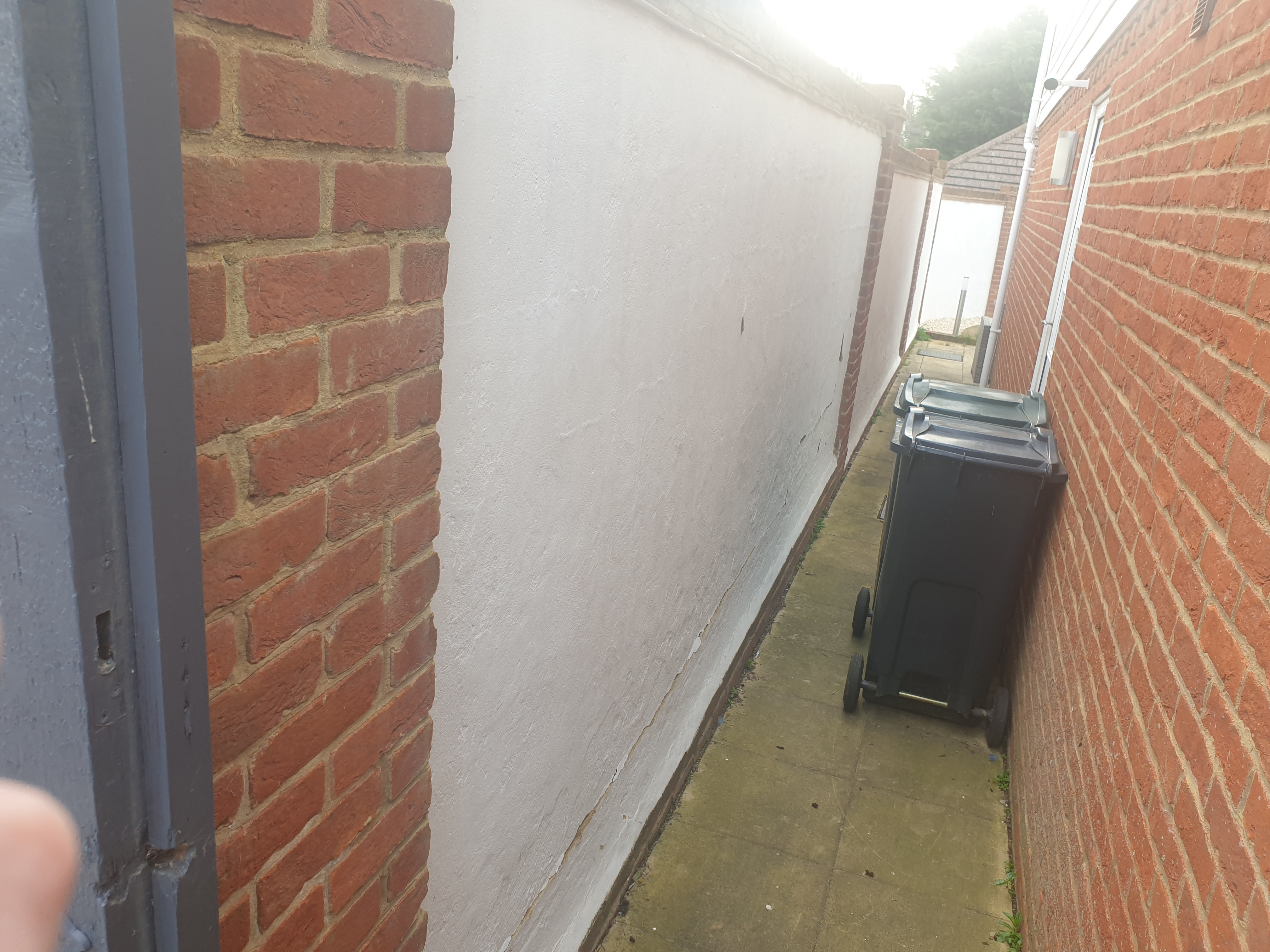We'd like to remind Forumites to please avoid political debate on the Forum... Read More »
📨 Have you signed up to the Forum's new Email Digest yet? Get a selection of trending threads sent straight to your inbox daily, weekly or monthly!
Garden Wall Cracked & Moving
Options
Comments
-
Having seen the passageway pictures I think it even less likely the gate has any significant role in what has happened to the wall. It is possible that there is something like a venturi effect taking place, but if so, increasing the airflow along the passageway may make things worse.Eldi_Dos said:@Exodi, regarding the gate, until finances are available to replace you could drill a couple of holes then using a multi tool cut out a slot.A few dotted about the wooden slats might even be a feature and help to lessen buffeting caused by wind.
0 -
I'm not convinced the wind and gate had that great an effect here, either.
A cheaper option than rebuilding the wall either as-is or thicker would be to move the gate further back along the side passage and replace the damaged part of the wall with a low wall section to mark the boundary. As the house wall is just behind it there should be little difference in terms of security.1 -
In which case, the wall would have fallen inwards.Section62 said:
Having seen the passageway pictures I think it even less likely the gate has any significant role in what has happened to the wall. It is possible that there is something like a venturi effect taking place, but if so, increasing the airflow along the passageway may make things worse.Eldi_Dos said:@Exodi, regarding the gate, until finances are available to replace you could drill a couple of holes then using a multi tool cut out a slot.A few dotted about the wooden slats might even be a feature and help to lessen buffeting caused by wind.
(Ooh, this one could run and run... :-). )0 -
Exodi, is that smooth rendered section made from single 4"concrete blocks? And is only that end section of the wall affected? (I think you said yes?)Exodi said:
If so, the most 'minor' solution could be to rebuild that section (surely essential to properly rebuild this?) using 6" blocks and increasing the brick pillar at the end by a further brick width.
Visually you wouldn't really be able to tell, as the gate's post sits over that pillar on its end, so its increased thickness won't be seen, and pretty much ditto for the rendered wall?
Yes, this will make the gate entrance 4" narrower - will that matter?0 -
IB Stock (they make bricks and blocks, so have a slight vested interest) have published some really good guides on recommended footing depths, maximum height, thickness and distances between piers (pillars). Whilst things vary on local conditions it's a great starting point.
Assume it's a 4" block wall that is 7' high. (edit: looking at the photos, it could be over 7'. If it's a 4" wall that's over 7' bordering a shared area, and it fell on someone, I'd expect the judge at the inquest to give everyone involved in its construction a very tough time)
What's the distance between the piers? The absolute maximum distance between the piers should be roughly 10', as you've already stretched the height of the wall for it's thickness (a 7' single block wall is a bit of a death trap).
Given you want to keep it a wall, are limited on thickness and want to keep the height, I'd suggest putting an extra pier in, to bring the distance between the piers down to well under 10'.
2 -
Yes regarding the venturi thing, I don't think this is the case here. The gate blew open a couple of times during storm Eunice. For this to happen, the wind would have been blowing from the back of the house to front, into the gate and would have needed to push the wall outwards maybe an inch so the gate latch no longer caught. The wall is mostly shielded from wind running perpendicular by houses, and in my (uninformed) view, wind running parallel to the wall shouldn't be an issue if it's able to run through.Bendy_House said:
In which case, the wall would have fallen inwards.Section62 said:
Having seen the passageway pictures I think it even less likely the gate has any significant role in what has happened to the wall. It is possible that there is something like a venturi effect taking place, but if so, increasing the airflow along the passageway may make things worse.Eldi_Dos said:@Exodi, regarding the gate, until finances are available to replace you could drill a couple of holes then using a multi tool cut out a slot.A few dotted about the wooden slats might even be a feature and help to lessen buffeting caused by wind.
(Ooh, this one could run and run... :-). )
But I agree with what most people say, the condition of the wall is 90% of the issue here, the storm, and possibly the gate, only exasperated the issue.
Nonetheless, if climate change means that windy days are likely to become more common, I'd like to at least remove one potential cause of this issue.Know what you don't1 -
I'm not sure of the size of the blocks, the render makes it hard to tell and unfortunately I wasn't involved with building the wall. It is single skin though yes.Bendy_House said:Exodi, is that smooth rendered section made from single 4"concrete blocks? And is only that end section of the wall affected? (I think you said yes?)
If so, the most 'minor' solution could be to rebuild that section (surely essential to properly rebuild this?) using 6" blocks and increasing the brick pillar at the end by a further brick width.
Visually you wouldn't really be able to tell, as the gate's post sits over that pillar on its end, so its increased thickness won't be seen, and pretty much ditto for the rendered wall?
Yes, this will make the gate entrance 4" narrower - will that matter?
There are cracks visible along the wall, but there only seems to be movement in the end pillar and first half of the wall, the second pillar seems to be stable and you aren't really able to move the wall applying pressure in second half of the wall.
Thatis an interesting idea though, will certainly think about!FaceHead said:
The wall is 210cm high so about 7' - about 500cm between the piers/pillars/columns so about 16.5', and about 6" thick.IBI Stock (they make bricks and blocks, so have a slight vested interest) have published some really good guides on recommended footing depths, maximum height, thickness and distances between piers (pillars). Whilst things vary on local conditions it's a great starting point.
Assume it's a 4" block wall that is 7' high. (edit: looking at the photos, it could be over 7'. If it's a 4" wall that's over 7' bordering a shared area, and it fell on someone, I'd expect the judge at the inquest to give everyone involved in its construction a very tough time)
What's the distance between the piers? The absolute maximum distance between the piers should be roughly 10', as you've already stretched the height of the wall for it's thickness (a 7' single block wall is a bit of a death trap).
Given you want to keep it a wall, are limited on thickness and want to keep the height, I'd suggest putting an extra pier in, to bring the distance between the piers down to well under 10'.
I think the consensus is that the wall is too thin for it's height.Know what you don't1 -
Your garden walls: better to be safe - GOV.UK (www.gov.uk)
This is a guide to the height of an unrestrained wall.
There are of course many walls thinner than this still standing.2 -
That would depend on whether the greater venturi effect was happening along the narrow passageway, or along the narrow driveway on the 'outer' side of the wall....Bendy_House said:
In which case, the wall would have fallen inwards.Section62 said:
Having seen the passageway pictures I think it even less likely the gate has any significant role in what has happened to the wall. It is possible that there is something like a venturi effect taking place, but if so, increasing the airflow along the passageway may make things worse.Eldi_Dos said:@Exodi, regarding the gate, until finances are available to replace you could drill a couple of holes then using a multi tool cut out a slot.A few dotted about the wooden slats might even be a feature and help to lessen buffeting caused by wind.
(Ooh, this one could run and run... :-). )....without a CFD model we will probably never know.1 -
Damn. It ain't going to run and run... :-(Section62 said:
That would depend on whether the greater venturi effect was happening along the narrow passageway, or along the narrow driveway on the 'outer' side of the wall....Bendy_House said:
In which case, the wall would have fallen inwards.Section62 said:
Having seen the passageway pictures I think it even less likely the gate has any significant role in what has happened to the wall. It is possible that there is something like a venturi effect taking place, but if so, increasing the airflow along the passageway may make things worse.Eldi_Dos said:@Exodi, regarding the gate, until finances are available to replace you could drill a couple of holes then using a multi tool cut out a slot.A few dotted about the wooden slats might even be a feature and help to lessen buffeting caused by wind.
(Ooh, this one could run and run... :-). )....without a CFD model we will probably never know.0
Confirm your email address to Create Threads and Reply

Categories
- All Categories
- 351.2K Banking & Borrowing
- 253.2K Reduce Debt & Boost Income
- 453.7K Spending & Discounts
- 244.2K Work, Benefits & Business
- 599.2K Mortgages, Homes & Bills
- 177K Life & Family
- 257.6K Travel & Transport
- 1.5M Hobbies & Leisure
- 16.2K Discuss & Feedback
- 37.6K Read-Only Boards





